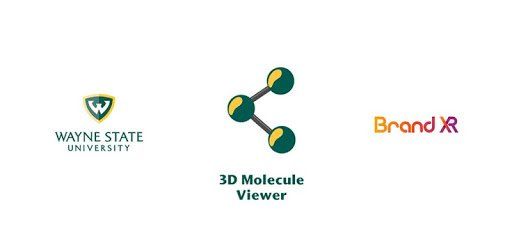BRANDXR AND WAYNE STATE UNIVERSITY BOOST LEARNING OUTCOMES USING AR

We are proud to announce BrandXR’s partnership with Wayne State University. This partnership is proof that education is changing and BrandXR is at the forefront of helping universities deliver world-class education experiences. The launch of Wayne University’s free 3D Molecule Viewer Augmented Reality App demonstrates that interactive learning is the future of education.
Wayne State Alumni and Co-Founder and CEO of BrandXR, Mahmoud “Moody” Mattan, partnered with Dr. Steven Firestine, from Wayne State’s Eugene Applebaum College of Pharmacy and Health Sciences, to create a new way for students to immersively study critical drug interactions that underpin biochemistry, medicinal chemistry, nursing, medical and pharmacology.
The Project
BrandXR and Wayne State University, have created an augmented reality learning app that visualizes 3D models of protein-drug complexes. With the app, users can learn how drugs interact with their targets on a molecular level. Students can customize the colors of proteins, ligands, and binding sites, rotate, and zoom in to see live changes for a more in-depth study of the molecule in a fun and immersive way. They can even take videos or photos of their molecular structures and share them with classmates or professors.
At BrandXR our primary goal in creating this experience was to reduce the learning curve in educating students on the critical interactions that underpin all of the biochemistry, medicinal chemistry, nursing, medical and pharmacology, by allowing them to visualize and manipulate 3D augmented reality holograms of structures of drugs and how they bind to their targets.
We also wanted to reduce the cost and accessibility barrier to entry, regardless of location, student background, or departmental financial resources of having access to specialized software.
Wayne State’s 3D Molecule Visualizer gives users the chance to visualize and manipulate 3D molecular holograms anywhere in the world – at the beach, in the classroom, or from the comfort of their own homes.
During the 2020 summer semester, Dr. Steven Firestine and a team of pharmacy students will find ways to incorporate the easy-to-use app into faculty lesson plans for the Fall. More drugs will be added to the database and students will be able to share feedback to shape the future of the tool.
The Future
We’ve all witnessed the difficulties of working, learning or simply just living from home during the COVID-19 pandemic. Amidst all this uncertainty the one thing we do know is that we need new ways of educating, connecting, and expressing ourselves and that sometimes this will need to happen in a virtual space. We’re thrilled to be working with a forward-thinking university like Wayne State to bring this vision to life in Detroit, Michigan.
Augmented reality and virtual reality were already rapidly advancing before this societal change and now resources are pouring into them at a faster rate as brands and institutions figure out how to keep the wheels turning while keeping teams safe. The 3D Molecular Viewer App is perfectly suited to bring students out of their textbooks and into 3D models that will test their knowledge with advanced practice that can be done anywhere in the world.
Augmented reality is not something to “put on the back-burner” and revisit in 5 years’ time. By then every brand will have an AR, VR, and mixed-reality presence to offer their users. People are creating truly valuable virtual experiences today in real-time.
Augmented reality can be practically applied to multiple levels of society to benefit our lives just like students at Wayne University are benefiting now. This partnership is the first step in bringing this technology to the field of education & medicine and many beyond such as brand marketing, corporate training, and eCommerce.
The app is free to download on Android & iOS so check it out and let us know what you think!
We love talking with our users and helping them solve problems.
Well, there you have it. We'll see you again in a couple of weeks but either hit that subscribe button or follow this blog as we plan to create much more metaverse and XR-related content moving forward!














